
- Home
- Age
- Brand
- American Art Decor (14)
- Antique (12)
- Coca Cola (11)
- Coca-cola (11)
- Dechane's (9)
- Esso (16)
- Firestone (14)
- Goodyear (13)
- Handmade (21)
- Madura Coats Treads (11)
- Michelin (8)
- Mobil (13)
- Mobil Oil (11)
- Samurai (44)
- Shell (10)
- Signs By Jake (11)
- Texaco (17)
- Unknown (19)
- Westinghouse (7)
- Winchester (27)
- ... (4550)
- Features
- 3d Effect, Led (8)
- Antique (3)
- Blow Mold (2)
- Decorative (5)
- Embossed (5)
- Embossed, 3d Effect (2)
- Framed (376)
- Framed, Signed (13)
- Gallery Stamps (2)
- Hand Painted (3)
- Handcrafted (3)
- Handpainted (9)
- Irregular Nails (5)
- One Of A Kind (ooak) (70)
- Reclaimed (27)
- Reclaimed, Salvage (8)
- Salvage (5)
- Signed (143)
- Unframed (73)
- Vintage (4)
- ... (4083)
- Material
- Type
- Acoustic (9)
- Baskets (9)
- Bowls (11)
- Boxes (46)
- Furniture (14)
- Kitchen Equipment (25)
- Marquee Sign (13)
- Metal & Ironwork (31)
- Painting (191)
- Paintings (14)
- Plaque (20)
- Plaques / Signs (18)
- Pottery (13)
- Print (22)
- Sculpture (13)
- Sign (48)
- Signs (76)
- Street Sign (19)
- Tools (11)
- Wooden Sign (9)
- ... (4237)
- Year
RARE Fine Antique Dutch Old Master Oil Painting, After Vermeer Signed
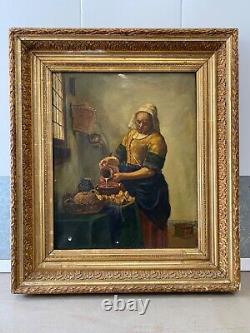
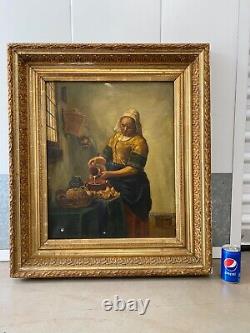
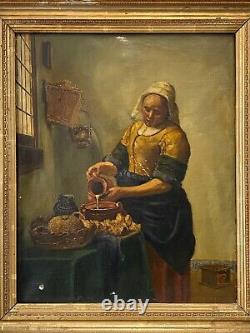
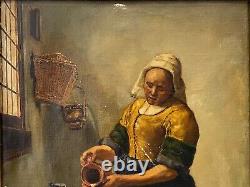
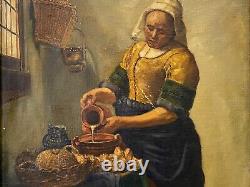
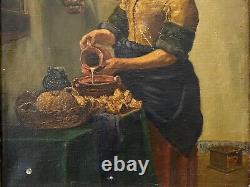
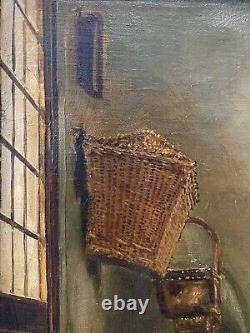
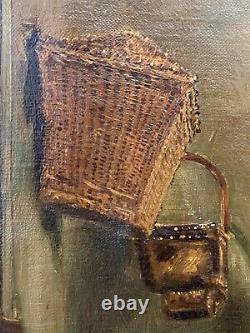
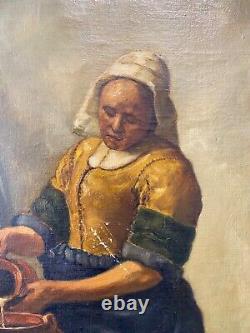
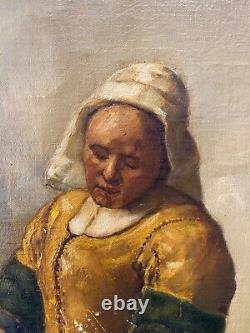
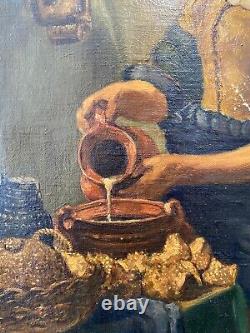
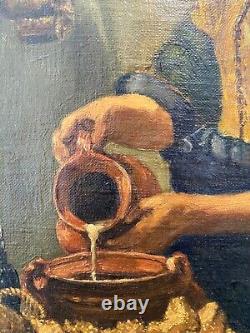
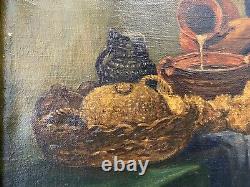
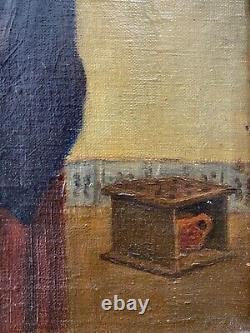
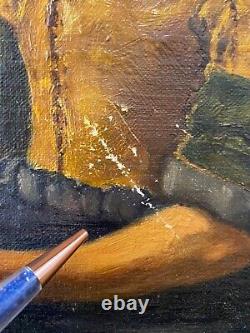





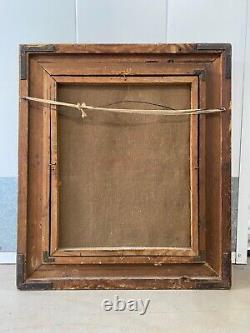
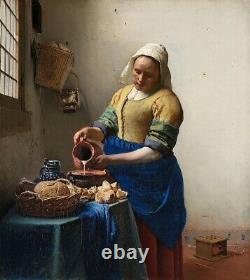


This is a fantastic and RARE Fine Antique Dutch Old Master Oil Painting on canvas, depicting Jan Vermeer's famous 1657 work, "The Milkmaid, " or De Melkmeid, which depicts a domestic kitchen made carefully pouring milk into an earthenware container. This particular artwork likely dates to the late 18th - early 19th century and is a very fine rendering of a Vermeer. I could not find any information on this painter, however there was a Dutch artist named Gerardus Van Veen, who lived from about 1620 - 1680 and painted naturalist subjects in watercolor. The artist of this particular work is possibly a descendant. Approximately 26 inches wide x 30 inches tall x 3 inches deep including frame.
Actual artwork is approximately 17 1/2 x 21 1/2 inches. Very good condition for centuries of age, with some fine craquelure, a few small scuffs to the painted canvas, and moderate edge wear and gesso loss to the ornate and substantial gilded 19th century wooden frame please see photos. If you like what you see, I encourage you to make an Offer. Please check out my other listings for more wonderful and unique artworks! About Johannes Vermeer (1632 - 1675).
1632 - Delft, The Netherlands. 1675 - Delft, The Netherlands. Interior genre and figure painting.Jan Vermeer Delft, Van Der Meer, Johannes Vermeer, Jan Vermeer Van Delft. The Dutch painter Jan Vermeer of Delft transformed traditional Dutch themes into images of fantastic poise and peace, rich with symbolic meaning. The documented facts about Jan Vermeer's life are few.
He was born on October 30 or 31, 1632, in Delft, Netherlands, the second of two children to Digna Baltens and Reynier Jansz. His father was an art dealer and silk weaver who also kept a tavern, and Vermeer probably took over the business after his father's death in 1655. It is presumed that his father, who was actively involved with the local artists and collectors, was an early influence on the young child. Vermeer supposedly began his training as an artist around the mid-1640s. In 1653 Vermeer married a well-to-do Catholic girl from Gouda; they had eleven children. In the year of his marriage, he became a master in the Delft painters' guild (an association), of which he was an officer from 1662 to 1663, and again, from 1669 to 1670. His dealings in works by other artists seem to have supported his family reasonably well until he was financially ruined following the French invasion of 1672, when France invaded the Spanish Netherlands. He died in 1675 and was buried on December 15. The following year his wife was forced to declare bankruptcy. Nothing is known about where Vermeer was educated and trained as a painter. Certainly Fabritius helped develop Vermeer's interest in perspective experiments (experiments with depth) and his use of a light-flooded wall as a background for figures. But Fabritius lived in Delft only after 1650, by which time Vermeer would have been well on his way toward the completion of his training.Considered to be earlier than The Procuress are two pictures that resemble it because of the color scheme, dominated by reds and yellows, and because they are larger in size and scale than Vermeer's later works. Diana and Her Companions, Vermeer's only mythological subject, is also suggestive of Italy. It is his only painting of figures in a landscape setting.
After these three diverse experiments, which may have owed something to Vermeer's familiarity with works in his father's stock of art, he painted the Girl Asleep at a Table, in which he used the warm range of colors of his other early pictures but in terms of subject matter and composition plunged into the mainstream of current Delft painting. The Soldier and Laughing Girl, marked the shift between Vermeer's early and mature works in that pointillé (gleaming highlights of thick layers of paint, which brightens the surface) appeared for the first time. Vermeer's style just before 1660 is also well represented by The Cook. The rich paint surface with its extraordinary quality, the monumental figure perfectly balanced in space and involved in a humble task, and the intense colors dominated by yellow and blue all show Vermeer at the height of his powers. Following these works, which are assumed to have immediately followed 1660, come the pearl pictures.
The Concert of about 1662 and the Woman with a Water Jug of perhaps a year later display the pleasing charms of this period. More complicated compositions and especially larger space representations mark the major works of the last decade of Vermeer's life. The Allegory of the Art of Painting c. 1670 is large and complex in both composition and meaning. On the whole it is not influenced by the hardness and dryness that weakened his later works, such as the Allegory of the Catholic Faith.
The quietness, peacefulness, order, and unchanging world of Vermeer's art provide hints of immortality, or the idea that one cannot be affected by death. Perhaps that is why this painter, whose works appear to be as clear as the light of day, has always been thought to be mysterious. New York: Harper & Row, 1970. Vermeer & the Art of Painting. New Haven, CT: Yale University Press, 1995."The Milkmaid" by Johannes Vermeer. "The Milkmaid" by Johannes Vermeer depicts a domestic kitchen maid, an indoor servant, and not a milkmaid who milks the cow.
She is carefully pouring milk into an earthenware container, now commonly known as a "Dutch oven". She is a young woman wearing a linen cap, a blue apron, and work sleeves pushed up from the forearms. Various art commentators have pointed to the possibility of symbols in the painting that suggest amorous references, while others argue to the contrary and that the maid is treated in an empathetic and dignified way. On the floor level, are some Delft wall tiles depicting some blue figures.
One of the blue characters on the tile is a cupid figure. The cupid is one of the amorous symbols, in this work, that follows the Dutch tradition of that time when maids were depicted as subjects of male desire.
Vermeer in his art has depicted many women in interior domestic scenes, and they all include interesting everyday details, as in this example. This painting's domestic features include. A variety of bread pieces on the table, and on the floor is a foot warmer. On the wall by the window are further kitchen utensils. As with many other Vermeer paintings, the exact year of this painting's completion is unknown, with estimates varying by different sources from 1657 to 1661.
This item is in the category "Art\Paintings". The seller is "willsusa_utzeqm" and is located in this country: US. This item can be shipped to United States.
- Signed By: Gerard Van Veen
- Size: Large
- Signed: Yes
- Period: Early 19th Century (1800-1830)
- Title: \
- Material: Canvas, Oil
- Region of Origin: California, USA
- Framing: Framed
- Subject: Figures, Still Life, Women
- Type: Painting
- Original/Licensed Reproduction: Original
- Item Height: 30 in
- Style: Dutch, Old Master, Realism
- Theme: Cultures & Ethnicities, Domestic & Family Life, Food & Drink, History, People, Portrait
- Features: One of a Kind (OOAK)
- Production Technique: Oil Painting
- Country/Region of Manufacture: Netherlands
- Handmade: Yes
- Item Width: 26 in
- Time Period Produced: 1800-1849

